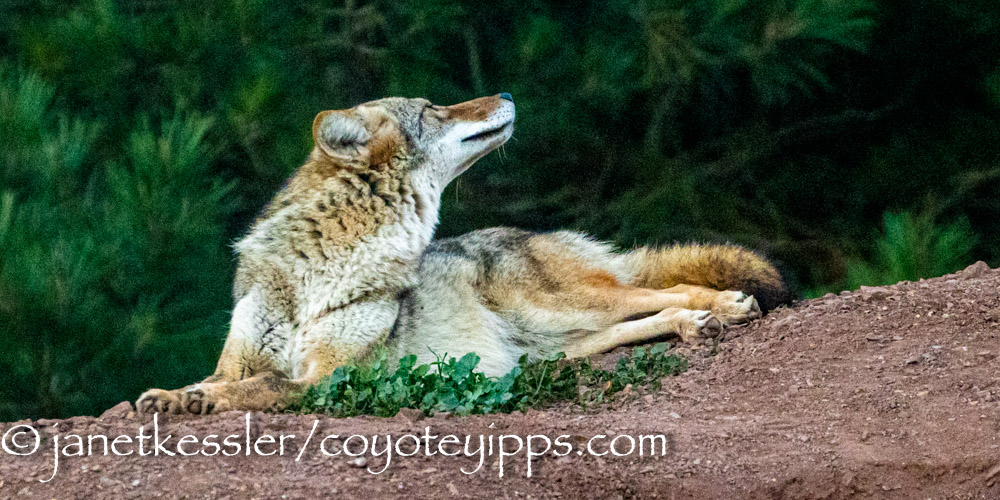Hello Janet,
This time of year is very busy for our wild canid. Foxes, Wolves and Coyote are prepping for parenthood, deep in courtship or fending off competition.
But not Slim Jim.
You may remember him from past reports as the very old Patriarch of a coyote pack. His mate and most pups and grandpups were killed by wolves last summer. He was injured badly, recovered and survived with his adult son, and 3 pups. 2 males and female Kinky Tail.
Fast fwd … Kinky Tail matured extremely fast and inherited their territory. Amazingly, this pup is courting and being courted. It appears she’ll be a yearling mom later this year.
The male pups and Yearling Male Big Brother dispersed. Slim Jim decamped for territory edge. It took the ranchers a while to realize he is not only ancient (10-13 years approx) but he is literally, nearly blind.

The Ranching family that knows and sees him often has viewed his cataracts on both eyes growing thicker especially last few months. Also .. if he’s with bison he moves freely with them. But when he’s by himself he is very tentative in certain spots. They have caught him in trail cams and literally he’s bumping into things. He never blinks when a trail cam flashes. He merely stares wide eyed and casting for smells. Finally … he doesn’t look at new items further away whereas formerly he was instantly aware. His senses of hearing and sight are clearly dulled greatly.
He attached himself last summer to a nursery herd of ranch bison. He literally follows them. Sleeps near them. And easily catches the countless rodents they disturb grazing. This Bison herd grazes nearly 5,000 acres in slow rhythmic moving and Slim Jim follows them in much of it. He has become nomadic because … the bison are so accustomed to him they are like guard and friends. Both calves and older bison treat him as non-event. I think he instinctively and by choice realized..the wide ranging but slow Bison are perfect. They stir up rodents every step. They chase any canid away (but have long accepted Slim Jim) They see, hear, and push away any dangers. They are a wall of protection. Also..this is a nursery herd. They are the nucleus of much bigger goals and herds. For now, the 25 or so bison are left alone to breed and range. So it’s perfect for Slim Jim’s last days.
The various packs on this property are either descended from Slim Jim, or long know him or don’t even bother him. He holds no threats from his battered old aura. He also doesn’t howl or bark messages any longer it seems. He is very low key as befits a lone old coyote.
His daughter does seem to welcome him when he comes round like a circuit traveler. And her new mate is calm and doesn’t drive him off. Slim Jim moves onward. Ever with bison.
The Bison also keep all non-coyote away. Any LGD, wolves or ranch dogs that go to bison range are in great danger. Several Bulls would love to score their horns on any canine. So Slim Jim … old, nearly blind, dull toothed … carries on.
He is stiff but moves well. And he tosses sticks and bones about. He listens long and seems distant. He seems very content. Its extremely rare to see a really old coyote in ranchlands. They don’t often make 4 or 5 years. His white face, battered body and wise demeanor are a real testament to so much. It’s fitting his last days are roaming with bison friends and guards as he meanders among descendants in his nomadic old age.
🐾❤Lou
[For more on Slim Jim’s past by Walkaboutlou, see Spring Madness, The Dilemma of Denning, Pack Strategies and Growing Pups, Nature, Family Update, and Kinky Tail, or put Walkaboutlou into the search box.]











